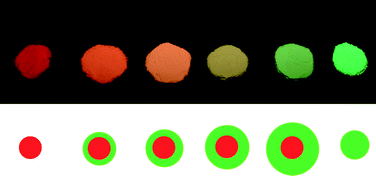Colour tuning of core–shell fluorescent materials
Abstract
Generally, two or more phosphors are mixed to achieve multiplex colour in the fluorescence industry. However, such a simple mixture of fluorescent materials usually leads to colour discrepancy and may even affect the colour uniformity due to the distinct physicochemical properties of the different components. Fabrication of a core–shell structure is a novel strategy to prepare colour-tuned fluorescent materials. Here we report a core–shell structure made up from two phosphors, Y2O3:Eu and LnPO4, which can emit red and green light respectively. It is important to control the homogeneous and relatively low supersaturation of LnPO4 (Ln = La, Ce, and Tb) in the solution so that the precipitates of LnPO4 can deposit onto the Y2O3:Eu particles uniformly. This could result in an LnPO4 shell around the Y2O3:Eu core to form micron-sized complex particles. In the preparation of the core–shell structure, the slow hydrolysis of tripolyphosphate to release free


 Please wait while we load your content...
Please wait while we load your content...